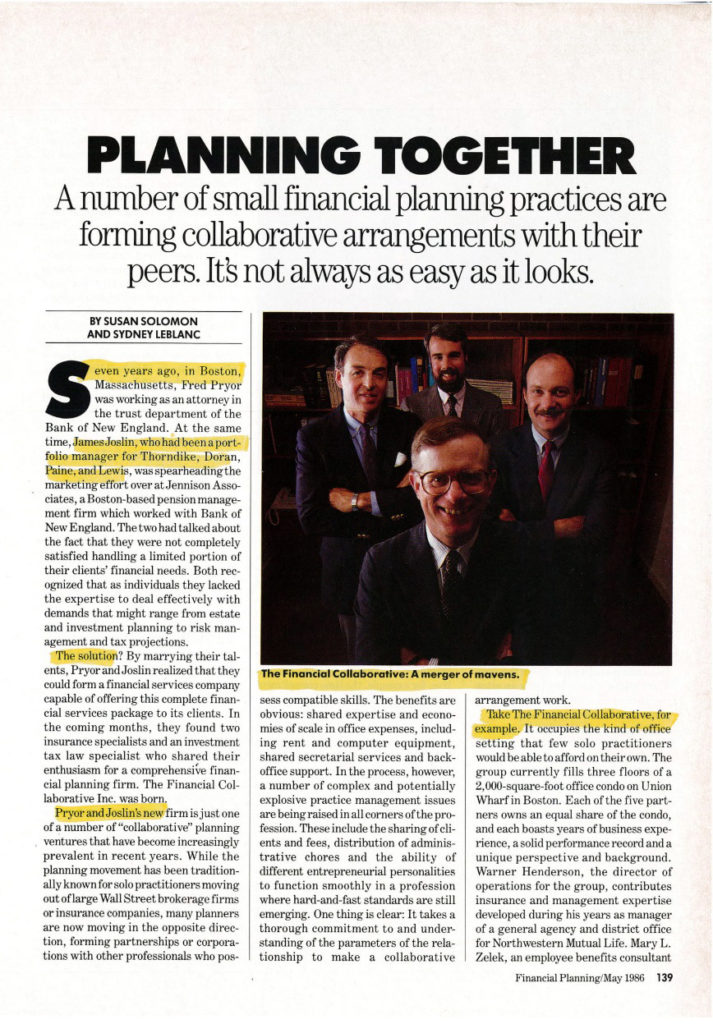Uncertain Beginnings
In the winter of 1980, five colleagues met in an office on Union Wharf overlooking Boston harbor to consider an innovative and disruptive approach to personal financial services. Represented around the table at that initial gathering were professionals in trust administration and banking, investment management, personal risk assessment and insurance counseling, and estate planning and settlement. Despite the diversity of perspectives at the table, the participants shared a common desire to provide unbiased advice to individuals in an environment where the client's interests were at all times front and center.
The model they discussed, novel for its time, was for a new approach to providing financial advice to individuals:
apply formal, organizational, and long-range strategic planning techniques to the personal financial decision-making process and offer these services to high net worth individuals through a fee-only platform
The initial work of these professionals resulted in a collaborative service offering; indeed, the name on the door of the firm's first office was The Financial Collaborative. In this new approach, a client interacts with personal risk, legal, and investment specialists to develop a comprehensive personal financial planning framework. Although this practice is now recognized as an essential part of most retail financial services relationships, in the early 1980s a favorable reception for such assistance was anything but assured. Significant missionary effort was required to gain acceptance for the discipline in the marketplace.
Six years later, Financial Planning Magazine in its cover article referred to TFC's advisory team as "a merger of Mavens."1 That was perhaps a bit of journalistic exaggeration, but in hindsight it was prescient. Thus, The Financial Collaborative, Inc. was formed as one of the early Registered Investment Advisor (RIA) firms whose business model was based solely on a continuing consultative relationship between the client and a trusted personal financial advisor. Today, the firm serves 340 distinct HNW client relationships (individuals, families, and non-profit boards) with that initial conceptual goal as its continuing mission and business model.

Coordinated Advice Integrated with a Network of Specialized Professionals Helping the Client Gain the Confidence to Act
Over the years, TFC has developed and refined these concepts and services, and built a network of outside specialist professionals who can be available to the firm's clients at a moment's notice. Individuals sometimes find the financial services and investment markets to be a maze of interlocking behind-the-curtain relationships to be navigated, and they are often required to do so without an advocate. Lacking the confidence to act, the usual result is either inaction or a spur-of-the-moment, emotionally-driven decision based on the advice of a commission-motivated seller.
Pioneering in the "Core-Passive" Portfolio and Fund Selection Approach
TFC broke other new ground with its supportive, consultative fee-for-service approach. Examples of its innovations include:
- investment portfolio composition based on strategic asset class allocation framework
- investment portfolio management in no-load mutual funds employing both passive and active approaches, rather than individually-selected common stocks and bonds
- direct international equity market exposure through specially targeted funds
- open architecture investment portfolio structure through the Schwab electronic funds trading and custody arrangement and in-depth fund manager research
Recognizing early on that most active managers (i.e., individual common stock pickers) tended to under-perform their benchmarks, TFC pioneered in the core-passive portfolio fund selection philosophy in which the client's account is structured around a foundation of passive equity and fixed income no-load funds or ETFs. In the mid-1980s, TFC joined with Dimensional Fund Advisors (DFA) which had identified the RIA market — and TFC in particular — as a partner in the application of its factor-based passive fund offerings. DFA's then ground-breaking three factor-based funds (value vs growth, company size, and market risk) became the underpinning for both fixed income and equity client portfolio segments. TFC's open architecture active fund manager research was directed toward adding excess return vs. asset class benchmark through careful choices of a few supplemental active managers.
Today, most active managers' claims of superior performance continue to ring a bit hollow, especially when returns are reported net and adjusted for fees. The active vs. passive management debate has swung decisively in favor of the passive side (i.e., index replication or factor-based so-called "smart beta" financial modeling techniques). However, a disciplined active fund manager research process can often add incremental risk-adjusted returns to a properly balanced account.
____________
1 Financial Planning Magazine, May 1986, P139
Proceed to Back to The Future: Boston, A Town Steeped in the Culture of Active Money Management >
Sign The Guestbook
The author welcomes your feedback. Please sign the Guestbook to let us know of your visit to this website. There is a place to offer your suggestions, comments and/or questions.
